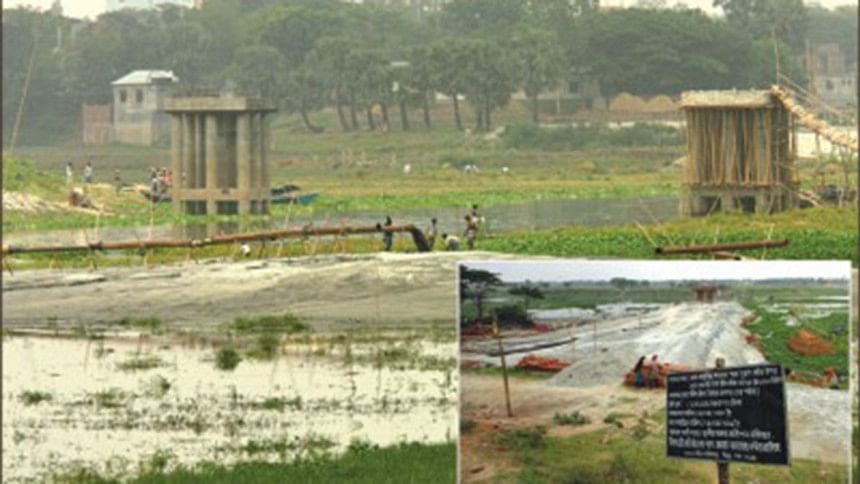Bureaucrats go to Turag

A group of serving Bangladesh Civil Service (BCS) officials from the administration cadre are launching a professional housing project on the bank of the Turag filling up a portion of the riverbed.
The Pratyasha housing project, which has around 400 members from different batches, is situated in Mudafa village in Tongi, Gazipur on the other side of the river.
Sources in Rajdhani Unnayan Kartripakkha have confirmed the project is not approved by Rajuk, adding that the administration officials are implementing the project abusing bureaucratic power.
Moreover, the cadre officials have also influenced an unplanned bridge, now under construction, over the Turag just to connect their housing project to the Tongi-Ashulia bypass.
Once completed, the low bridge will choke the river traffic on the already dying Turag.
The Bangladesh Inland Water Transport Authority insiders say they have formally informed the Local Government Engineering Department of their objection to the low height of the bridge. But the LGED is firm to build the bridge violating the BIWTA objection.
In 1994-95, the then deputy commissioner of Gazipur and some other officials from his batch initiated the housing project. They bought around 23 acres of land, locally known as Goltek and Muchir Tek, in Mudafa by the river.
They later levelled the land without taking permission from Rajuk and also filled up some portion of the riverbed to protect the site from erosion.
During a visit to the project yesterday, it was seen the river is around 50 feet away from the housing area.
But in the Cadastral Survey that ended in 1940, the width of the river was shown here to be around 200 feet. The BIWTA claims it to be around 100 feet after their dredging under the 'circular water way' project.
However, indiscriminate encroachment on the river has in fact left the width no more than 50 feet.

Asked, an additional secretary from the Ministry of Health who is a key member of the project said they did not violate any rules and regulations.
"We did everything obeying the rules and regulations," he said. When asked about the under-construction bridge, he said there is a connecting road on the other side.
During yesterday's visit, no connecting road was found on either side of the bridge. The authorities of Pratyasha are now paving a new road in the area so that they can go to the estate easily.
Now the members of the project need to go to the housing area through Cherag Ali Bazar in Tongi.
The additional secretary said there are some old trees, which 'substantiate' their claim that the site was highland.
But only some palm and hijal trees are there and these species naturally grow in the wetland. Plain land trees including coconut and
other wood trees are not more than five years old there.
Md Faridul Islam, protocol officer of former prime minister Khaleda Zia, is one of the members of the project, sources say. He used to influence the LGED and BIWTA offices to make the bridge as a government project, they add.
The BIWTA officials found the bridge an obstacle to implement the circular waterway and recommended that LGED should demolish it. But LGED wanted to construct the bridge only to facilitate the housing project.
"If they erect the bridge, it will be a permanent disaster for the Turag as no water transport will be able to pass under it," commented a high official from BIWTA.
"If the government officials don't obey the laws, how can we expect that the commoners will do that?" the official asked.
The workers carrying out the construction yesterday said it would be a Bailey bridge.
Now no water vehicles can go under the Ashulia Bridge across the Turag due to its low height. The BIWTA is planning to make a higher bridge at the Ashulia point for the passage of the vessels.
"The condition of Turag is really horrible. Not only grabbing, if the government does not stop construction of the bridge, it will permanently ruin the river," said the BIWTA official.
Earlier in the 80s, the Rampura Bridge created a permanent obstacle to a river route that used to connect the Balu river with Karwan Bazar. The bridge eventually led to the end of the Begunbari and Hatirjhil canals.
The bridge connecting the administration officials' housing project and Ashulia road is likely to bring in similar fate for the river route there.

 For all latest news, follow The Daily Star's Google News channel.
For all latest news, follow The Daily Star's Google News channel. 








Comments